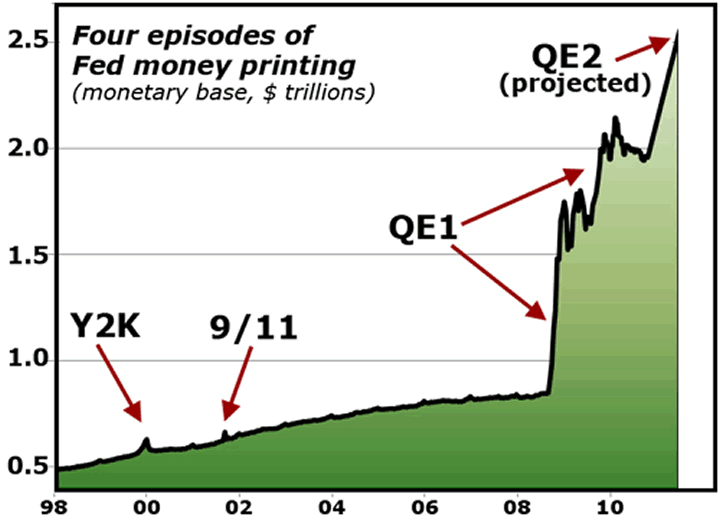Fed QE Money Printing Getting Even Wilder!
Interest-Rates / Quantitative Easing Nov 15, 2010 - 07:53 AM GMTBy: Martin_D_Weiss
 I’ve seen a lot of crazy monetary shenanigans in my lifetime — in Brazil, Japan and elsewhere.
I’ve seen a lot of crazy monetary shenanigans in my lifetime — in Brazil, Japan and elsewhere.
But I’ve never seen anything quite like the explosion of out-and-out money printing we’re witnessing in the United States today.

Look. Back in 1999, Fed Chairman Alan Greenspan poured money into the economy to help soften the impact of the feared Y2K bug. Monetary experts thought he had gone wild.
Two years later — this time in response to the 9-11 terrorist attacks — Greenspan did it again. He ran the money printing presses and tried to flood the banking system with liquidity. They said he had gone wilder.
But the piles of money Greenspan printed during those two episodes are anthills in comparison to the mountains Ben Bernanke is printing today.
Below are the numbers. They’re mindboggling.
#1 — Y2K.Between October 6, 1999 and January 12, 2000, the Fed pumped in $73 billion in three months (based on the Fed’s measure of the U.S. monetary base).
#2 — 9-11. In the days immediately following the attacks through September 19, 2001, Greenspan rushed to pump $40 billion into the U.S. economy — one of the largest amounts ever recorded for such a short period.
#3 — QE1. In response to the debt crisis of 2008-2009, the Fed embarked on its first round of “quantitative easing” — buying bonds to pump more money into the economy.
As a direct result, the monetary base exploded by $1.3 trillion from September of 2008 to February of 2009.
That was nearly 18 times larger than the Y2K episode and 32 times larger than the 9-11 money pumping.
#4 — QE2.Bernanke’s Fed just announced a second round of quantitative easing (QE2) slated to be smaller than the first — $600 billion.
So based on the idea that it’s smaller, apologists for the Fed want you to believe that all is OK — that it’s nothing more than a “relatively moderate” maneuver.
That’s baloney! Pure hogwash!
Why? Because the QE1 and QE2 money printing is cumulative.
In other words …
The $600 billion of new money printing, which Bernanke just announced on November 3, is being piled on TOP of his first round of money printing.
Is this standard operating procedure for the Fed?
Heck no!
In fact, soon after the Y2K and 9-11 money printing binges, Greenspan’s Fed immediately sucked all the extra funds out of the economy: He promptly REVERSED those two money printing binges!
Bernanke has been promising something similar — the so-called “exit strategy.” But where did the exit strategy go?
My view: It probably never existed to begin with. Instead, it’s bound to go down in history as one of the greatest broken promises of all time.
Worse, it’s very possible Bernanke’s real plan was not to exit. It was to dive in even deeper, and that’s exactly what he’s doing right now — all based on the lame excuse that “inflation is too low.”
My recommendation is three-fold.
First, if you’re overloaded with contra-dollar assets like commodities and foreign currencies, consider taking some hefty profits. Reduce your exposure, and save it for the next major buying opportunity.
Second, don’t get caught in traditional, buy-and-hold strategies. The giant see-saw in the stock market since 2000 should teach you that lesson. Keep plenty of liquid cash. Stay flexible.
Third, see our latest video for additional guidance. It goes permanently offline tonight.
Good luck and God bless!
Martin
This investment news is brought to you by Money and Markets. Money and Markets is a free daily investment newsletter from Martin D. Weiss and Weiss Research analysts offering the latest investing news and financial insights for the stock market, including tips and advice on investing in gold, energy and oil. Dr. Weiss is a leader in the fields of investing, interest rates, financial safety and economic forecasting. To view archives or subscribe, visit http://www.moneyandmarkets.com.
© 2005-2022 http://www.MarketOracle.co.uk - The Market Oracle is a FREE Daily Financial Markets Analysis & Forecasting online publication.



